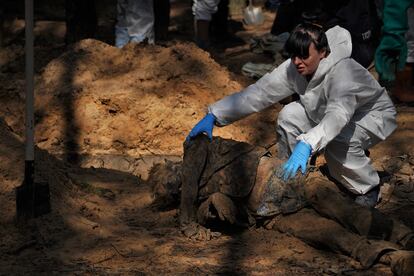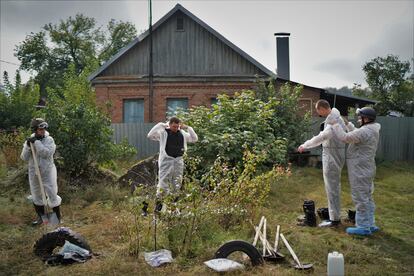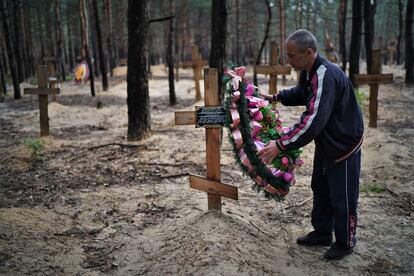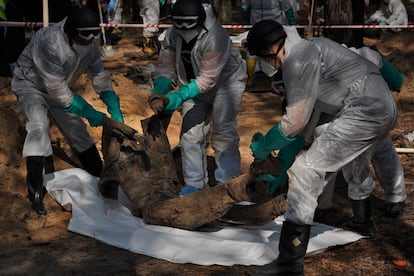Torture and mass graves: The horrors of the Russian occupation of Izium
EL PAÍS joined investigators as they exhumed bodies from a wooded area of the town. Many of the victims were shot, while others were found with rope tied around their necks

Ukrainian authorities estimate that more than 400 people were buried in a wooded area of Izium, a town in northeastern Ukraine, after being killed during Russia’s six-month long occupation. Many of the victims were shot dead, while others showed signs of torture. Others died in bombings or from illness caused by poor living conditions. On Saturday, workers in white coveralls dug their shovels into the ground next to each of the wooden crosses. After digging around 80 centimeters, they reached their goal. The work slowed down until they were able to extract the body. Some couldn’t handle the nausea. No voice was louder than another, despite the fact that more than 50 people were working at the same time in several graves. The area, spotted with holes like Gruyère cheese, was delimited with plastic tape tied to tree trunks. These were the first steps Ukrainian authorities have taken to reveal the crimes of Russia’s occupation of Izium.
Natalya, with jet black hair and a snow-white coverall, approached the corpses as they were pulled from the ground. Some have been buried for months based on their current state. The woman, who did not want to make any statements or give her last name, was not wearing a mask. She seemed immune to the pestilence and horror before her. Her blue rubber gloves first removed the dirt from the corpse’s face and then from the rest of the body. Crouching down, she then moved the joints, lifted the clothes, touched the belly, examined the teeth... She often lowered her eyes a few centimeters from the remains to take in the details. Some garments, already in poor condition, fell apart when touched. As she examined the body, she made comments that were jotted down by a member of the Ukrainian Prosecutor’s Office. “Blue cotton underpants; black cotton socks. The body is in an advanced stage of decomposition. Gray hair about two inches long. The eyes are rotting. Partially extracted denture. The body shows no sign of torture.”

Investigators also looked through the victims’ pockets for documents or personal objects that could help identify the body. If something was found, they put it in a plastic bag with the number allocated to the victim. Of the bodies exhumed on Saturday, nearly a dozen could not be identified. The corpses were placed in white body bags, with the victim’s gender and number written in black letters. Numbers 106, 107, 108 and 116 were women, while number 92 was a man. They were all marked as “unidentified.” Some bodies, however, were able to be identified. From grave 117, investigators exhumed Alexei Zolotorov. A wooden slat said he was born on March 15, 1990, and died on March 29.
Kyiv has opened an investigation into whether Russian forces committed possible war crimes during its six-month occupation of Izium. Thousands of Russian soldiers fled after Ukraine launched a successful counteroffensive on September 6. But at least two Russian soldiers, who were unable to flee, were arrested, according to images recorded by local soldiers to which EL PAÍS has had access. Meanwhile, in the outskirts of Izium, technicians have been trying to repair power lines, while deminers have been combing the area with metal detectors. The Russian occupation has left behind a trail of devastation in Izium, just as it did last April in Bucha, near Kyiv.

Some of the bodies exhumed from the forest in Izium had their hands tied behind their backs. Others were shot or showed signs of torture. In some case, there was rope around the victim’s neck, according to sources from Ukraine’s War Crimes Prosecutor’s Office. On the path that led to the sea of wooden crosses, most of which were identified by just a number in a felt-tip pen, one grave was bigger than the others. That grave contained the remains of 17 local soldiers who had been transferred from the morgue and buried together. Sources from Ukraine’s War Crimes Prosecutor’s Office said that the victims had been shot and some tortured. But it is not known if they died on the same day. “Three of them have been identified by the documents they were carrying,” confirmed Roman Kasjanenko, from the region’s Prosecutor’s Office.
One of the few victims identified was five-year-old Olesya Stolpakova, who died on March 9 with her parents. That day, Russian aircraft bombed an apartment block in the center of Izium, killing dozens of people. The building was broken in two and is now surrounded by rubble. Before the Russian invasion, Izium was home to around 45,000 people; today it is a ghost town. Back in the wooded area, a couple, Oxana and Volodymyr, arrived to look for the bodies of an aunt and a cousin who has also been killed in the bombing.
A notebook with information about the burials has been helping investigators to identify the victims. The notebook was kept by a man who kept burial records before the Russian occupation. “He did what he had to do under the occupation, bury people,” said Yuri Kravchenko, chief forensic doctor of the Kharkov region, before adding that the worker probably had no choice. According to Kravchenko, when the exhumations began on Friday, the worker was already at the site and helping police.

The first to arrive at the mass grave site on Saturday was Alexander. He rode his bike to the forested area just before 10am, when investigators were still getting into their coveralls. Alexander was there to visit the grave of his mother, Alina, who died at age 69 on May 18, during the Russian occupation, due to poor health. The wooden cross that marked her grave was one of the few with a name. Alexander lifted the flower wreath against the cross to show the plaque, with her name, date of birth and date of death. He paid 2,200 hryvnias (about $55,) for a funeral, supervised by the Russian military, that he was able to attend. “I was lucky because I got them not to charge me for the coffin,” said Alexander, a gas station worker by profession.
“I don’t think all Russians are to blame for this like [Russian President Vladimir] Putin and his team,” said Alexander, next to his mother’s grave. Alina herself was born in Belarus, which supports the Kremlin. “It is normal here that almost all of us have family and people we know in Russia and Belarus,” he added. The Kharkiv region, where Izium is located, borders Russia, and many residents have kept ties with the neighboring country, even after Ukraine became independent in 1991, with the fall of the Soviet Union. Alexander, meanwhile, said he was wracked by grief. He was surprised by the Russian invasion of Ukraine, and even though, his mother was not a direct victim of the war, he has decided to leave her body in the pine forest as a reminder of the horrors carried out by their Russian neighbors.

Tu suscripción se está usando en otro dispositivo
¿Quieres añadir otro usuario a tu suscripción?
Si continúas leyendo en este dispositivo, no se podrá leer en el otro.
FlechaTu suscripción se está usando en otro dispositivo y solo puedes acceder a EL PAÍS desde un dispositivo a la vez.
Si quieres compartir tu cuenta, cambia tu suscripción a la modalidad Premium, así podrás añadir otro usuario. Cada uno accederá con su propia cuenta de email, lo que os permitirá personalizar vuestra experiencia en EL PAÍS.
¿Tienes una suscripción de empresa? Accede aquí para contratar más cuentas.
En el caso de no saber quién está usando tu cuenta, te recomendamos cambiar tu contraseña aquí.
Si decides continuar compartiendo tu cuenta, este mensaje se mostrará en tu dispositivo y en el de la otra persona que está usando tu cuenta de forma indefinida, afectando a tu experiencia de lectura. Puedes consultar aquí los términos y condiciones de la suscripción digital.
More information
Últimas noticias
Maduro to be tried in the US for narcoterrorism and corruption
Maps of the US attack on Venezuela: Targets, airspace and deployed fleet
Venezuelans in exile: ‘This could be the end of a very dark chapter for Venezuela, but also the beginning of a time of uncertainty’
Key points of the military attack on Venezuela: Early morning bombings and a ‘captured’ president
Most viewed
- Alain Aspect, Nobel laureate in physics: ‘Einstein was so smart that he would have had to recognize quantum entanglement’
- David King, chemist: ‘There are scientists studying how to cool the planet; nobody should stop these experiments from happening’
- Mexico completes its trade shift with the entry into force of tariffs on China and countries without trade agreements
- Reinhard Genzel, Nobel laureate in physics: ‘One-minute videos will never give you the truth’
- Oona Chaplin: ‘I told James Cameron that I was living in a treehouse and starting a permaculture project with a friend’











































